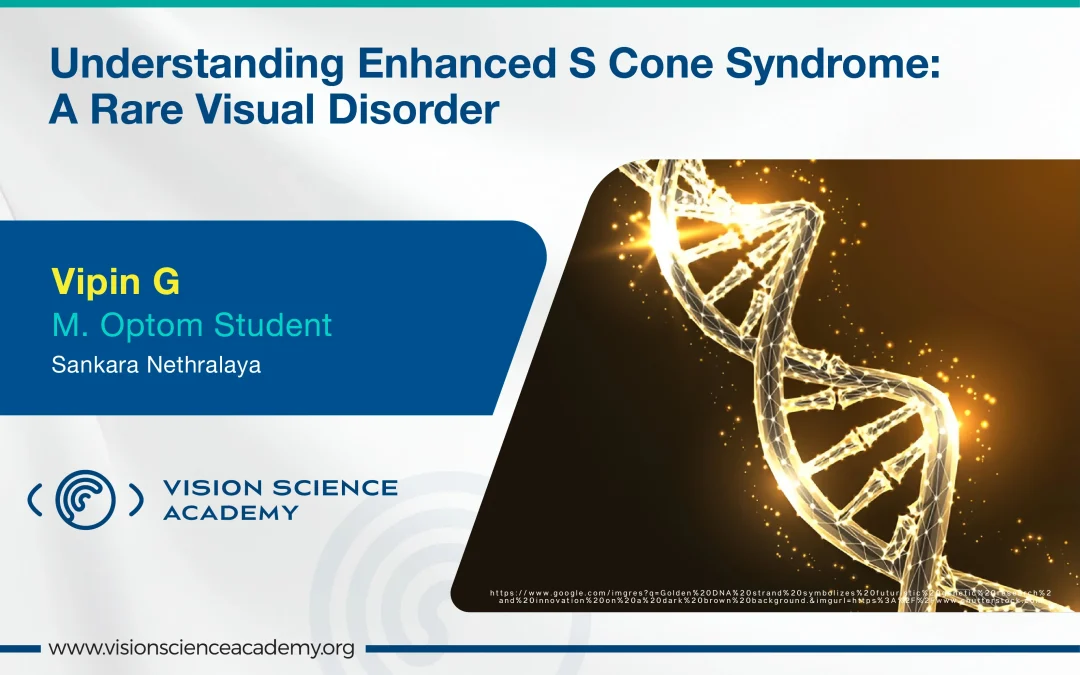Vipin G., B.Optom.
M.Optom Student, Sankara Nethralaya, Chennai, India
Enhanced S Cone Syndrome (ESCS) is a rare genetic condition that affects vision, specifically the function of the cone cells in the retina. These cone cells are crucial for colour vision and sharp central vision. While most people have three types of cone cells (S, M, and L cones corresponding to short, medium, and long wavelengths of light), those with ESCS have an abnormal increase in the number of S cones. (1,2)
What is Enhanced S Cone Syndrome?
ESCS is a hereditary disorder characterised by an overabundance of S cones, which are sensitive to short wavelengths of light (blue light). This unusual distribution of cones leads to distinct visual abnormalities. The condition is also known as Goldmann-Favre Syndrome. (1,2)
Causes and Genetics
ESCS is typically inherited in an autosomal recessive manner, meaning both copies of a specific gene must be altered for an individual to be affected. Mutations in the NR2E3 gene are most commonly associated with ESCS. This gene plays a critical role in the development and function of photoreceptor cells in the retina. (2,3)
What is NR2E3 Gene?
The NR2E3 gene, located on chromosome 15, encodes a nuclear receptor protein that plays a crucial role in the development and function of photoreceptor cells in the retina. This protein is vital for the proper differentiation and maintenance of rod and cone photoreceptors, which are essential for night vision and colour vision, respectively. NR2E3 acts as a transcription factor, it ensures a balanced development of rod cells and cone cells. Specifically, NR2E3 suppresses the formation of S cones while promoting the development of rod cells and M/L cones. (2,3)
Symptoms of Enhanced S Cone Syndrome
Individuals with ESCS typically exhibit a range of visual symptoms, which can vary in severity: Night Blindness, Photophobia, Reduced Central Vision, Abnormal Colour Vision, and Progressive Vision Loss. Night blindness is one of the earliest and most common symptoms, making it difficult for individuals to see in low-light conditions. This is often the first indication of the disorder. (3,4)
Diagnosis
Diagnosing ESCS involves a combination of clinical evaluation, family history, and specialised tests: Electroretinography (ERG), Fundus Examination, and Genetic Testing. These reveal the changes in responses of retinal photoreceptor cells, fundus changes, and genetic identification. (3,4)
Role of Optometrist and Management Options
ESCS is diagnosed by the optometrists with the help of accurate history, clinical examination that included vision testing and colour vision assessment, and investigative procedures including Electroretinogram (ERG), Optical Coherence Tomography (OCT) and Fundus Autofluorescence (FAF).
Currently, there is no cure for ESCS, but several approaches can help manage the symptoms and improve the quality of life for those affected with the help of low vision aids assist with daily tasks, photophobia management, regular monitoring of the progression of the condition, genetic counselling to understand the inheritance pattern and risks for future generations. (5)
Enhanced S Cone Syndrome is a rare and complex visual disorder that significantly impacts those affected. Understanding the symptoms, causes, and management options is essential for patients, families, and healthcare providers. Continued research and advancements in genetic therapies offer hope for improved treatments and outcomes in the future. By raising awareness and fostering a supportive community, we can better address the challenges posed by this condition and enhance the quality of life for those living with ESCS.
References:
- Wang, Y., Wong, J., Duncan, J. L., Roorda, A., & Tuten, W. S. (2023). Enhanced S-cone Syndrome, a Mini-review. Advances in experimental medicine and biology, 1415, 189–194. https://doi.org/10.1007/978-3-031-27681-1_28
- Tsang, S. H., & Sharma, T. (2018). Enhanced S-Cone Syndrome (Goldmann-Favre Syndrome). Advances in experimental medicine and biology, 1085, 153–156. https://doi.org/10.1007/978-3-319-95046-4_28
- Alnosair, G., & Aljayani, R. (2023). Suspected Enhanced S-Cone Syndrome: A Case Report. Cureus, 15(8), e43660. https://doi.org/10.7759/cureus.43660
- Wang, Y., Wong, J., Duncan, J. L., Roorda, A., & Tuten, W. S. (2023). Enhanced S-Cone Syndrome: Elevated Cone Counts Confer Supernormal Visual Acuity in the S-Cone Pathway. Investigative ophthalmology & visual science, 64(10), 17. https://doi.org/10.1167/iovs.64.10.17
- Roman, A. J., Powers, C. A., Semenov, E. P., Sheplock, R., Aksianiuk, V., Russell, R. C., Sumaroka, A., Garafalo, A. V., Cideciyan, A. V., & Jacobson, S. G. (2019). Short-Wavelength Sensitive Cone (S-cone) Testing as an Outcome Measure for NR2E3 Clinical Treatment Trials. International journal of molecular sciences, 20(10), 2497. https://doi.org/10.3390/ijms20102497


Recent Comments